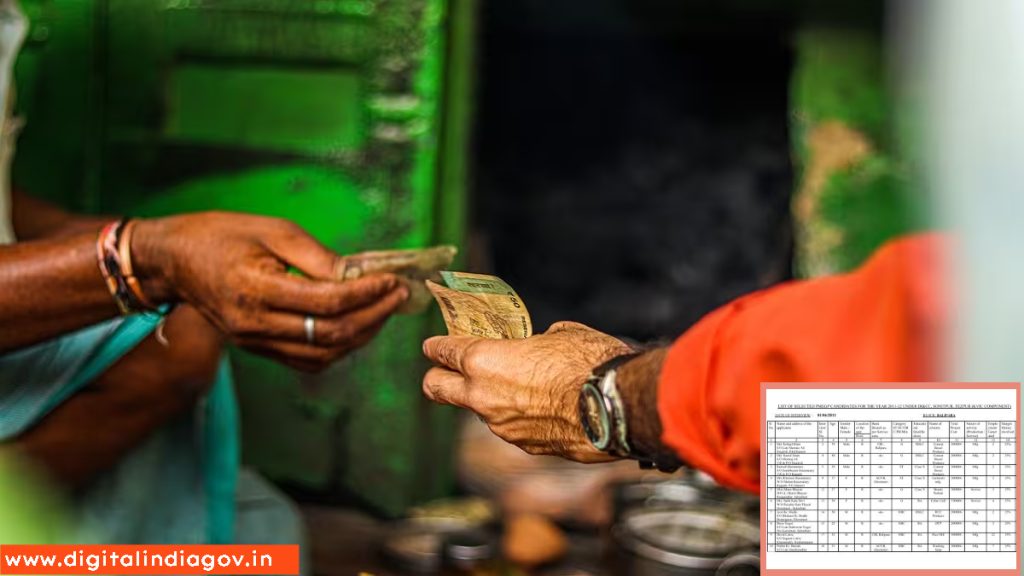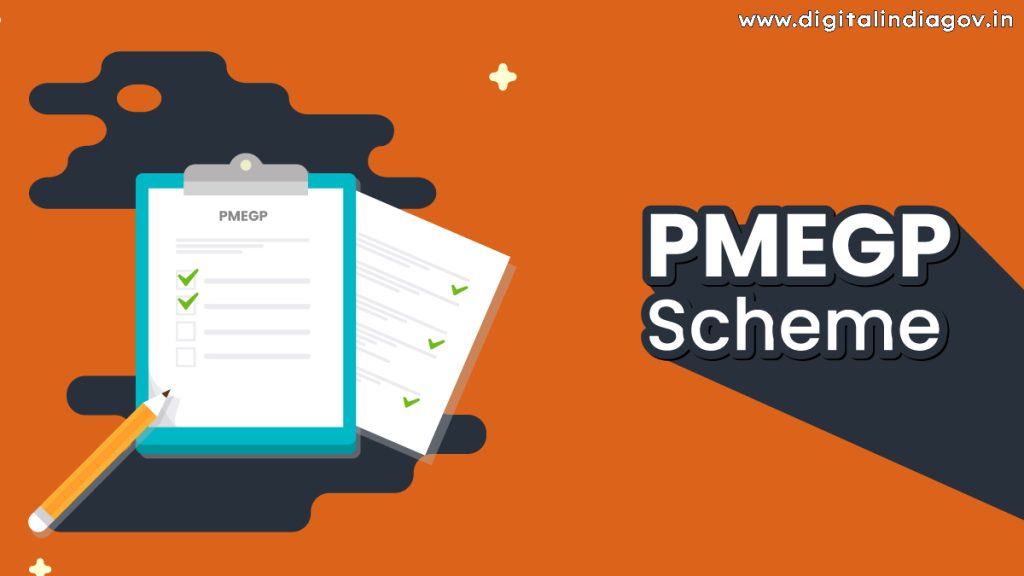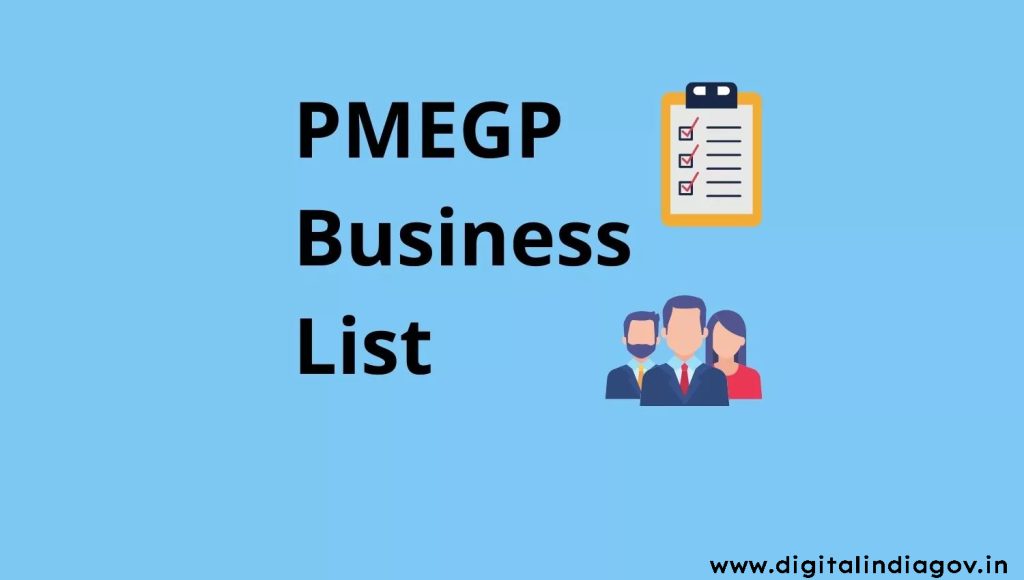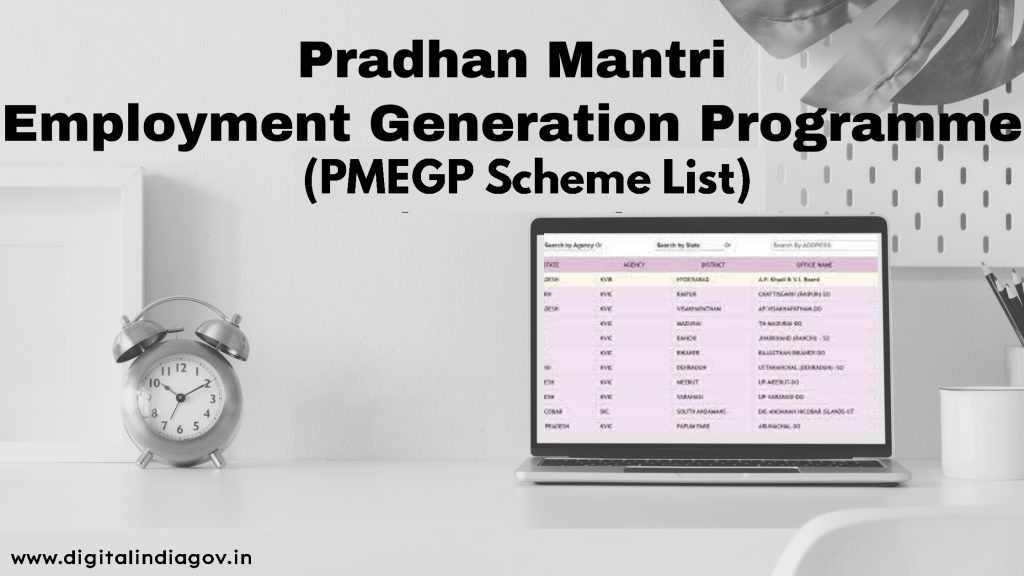PMEGP Scheme List:- The Indian government launched the credit-linked Prime Minister’s Employment Generation Programme (PMEGP) in 2008. Under PMEGP, the Rural Employment Generation Programme and the Prime Minister’s Rojgar Yojna were combined. This program helps unemployed youth and traditional artisans establish micro-enterprises in the non-farm sector, with the goal of creating opportunities for self-employment. The Ministry of MSME oversees the Prime Minister’s Employment Generation Programme (PMEGP). The Khadi and Village Industries Commission (KVIC) is the federal agency responsible for implementing the PMEGP Scheme. The State Khadi and Village Industries Commission Directorates, State Khadi and Village Industries Boards, District Industries Centres, and banks are the entities implementing the Scheme at the State level.
Contents
Objectives of Prime Minister’s Employment Generation Programme
- creation of opportunities for ongoing, sustainable self-employment in both rural and urban areas of the nation
- establishing micro businesses to give a significant portion of young people without jobs in rural and urban areas, as well as traditional and aspiring artisans, long-term, stable employment
- Encouraging financial institutions to participate in order to increase the flow of credit to the micro sector.

Also Read:- Agneepath Scheme Apply
Eligibility for PMEGP Scheme List
- Passing Standard VIII is necessary for projects costing more than Rs 5 lakh in the service sector and more than Rs 10 lakh in the manufacturing sector, for people who are at least 18 years old.
- Organizations recognized by the Societies Registration Act of 1860 Cooperative societies centered on production
- Self-help organizations and benevolent trusts
Benefits of the PMEGP Scheme?
The following are some additional benefits that this scheme offers:
- Bank-financed subsidy programs are made available under this scheme to promote new microenterprises in the non-farm sector.
- Get a Margin Money subsidy of up to ₹50,00,000 for projects in the manufacturing sector and ₹20,00,000 for projects in the service sector at 15% to 35% bank loan ranges.
- The benefits of the Margin Money subsidy are up to 25% in urban areas and 35% in rural areas for special categories such as SC, ST, physically handicapped, women, minorities, NER, or ex-servicemen.
Salient features of the PMEGP Scheme List
- The State Khadi and Village Industries Commission Directorates, State Khadi and Village Industries Boards, District Industries Centres, and banks in Urban and Rural areas carry out the Scheme in a 30:30:40 ratio between the Khadi and Village Industries Commission, Khadi and Village Industries Boards, and DIC. Thus,
- Only recently established units are eligible to receive assistance under the PMEGP.
- There is no upper limit on income when starting projects.
- Existing units or those currently receiving State or Central government subsidies are not eligible.
- This program is available to any industry, including coir-based projects (apart from those on the negative list).
- In plain areas, the scheme’s per capita investment cannot exceed Rs 1 lakh, and in hilly areas, it cannot exceed Rs 1.5 lakh.
- In the service sector, the maximum project cost is Rs 10 lakh; in the manufacturing sector, it is Rs 25 lakh.
Areas of Operation
The Khadi and Village Industries Commission Act 2006 – Scheme defines a rural area as any area that is part of a village, including a town. The population should not be more than twenty thousand, or any other number that the Central Government may from time to time designate. District Industries Centres (DIC) are the only ones included in the urban area.

Also Read:- CG Bhuiya
Negative list of activities
- Companies / Industries involved in the production, processing, or sale of meat or alcoholic products such as cigarettes, pan, or beedi.
- Companies and sectors related to horticulture, floriculture, cultivation, and sericulture.
- Production of carry bags with a particle size of less than 20 microns made of recycled plastic or polythene
- Processing pashmina wool and other goods that fall under the Khadi Certification Rule’s jurisdiction includes hand spinning and hand weaving.
- Transport in rural areas: houseboats, shikaras, tourist boats in the Andaman and Nicobar Islands, autorickshaws, and cycle rickshaws in Jammu & Kashmir Only the Andaman and Nicobar Islands and the country’s northeast will be able to use CNG autorickshaws, subject to the Chief Secretary of State’s prior approval and merit-based assessment.
Margin
For borrowers in special categories, the margin money contribution is 5% of the project cost; for borrowers in general categories, it is 10%. As an example: If Miss Nishitha applies for a loan of Rs 8 lakh at XYZ bank, the bank may only finance 80% of the total loan amount, or Rs 6,40,000. Nishita must make arrangements for the margin money, which is the remaining 20%, or Rs 1,60,000.
Subsidy
- General Category: In rural areas, 25% of the project’s cost is eligible for a subsidy, and in urban areas, 15%.
- Special Category: In rural areas, the eligible subsidy is equal to 35% of the project cost, while in urban areas, it is 25%.
How does this scheme work?
Assume Mr. Don, a recent graduate from Bangalore Urban who wishes to apply for the PMEGP program. Project Cost Estimate: Rs. 10 lakh The mandatory contribution of Rs 1 lakh (10% of Rs 10 lakh) was made by Mr. Don under the PMEGP The sum that Mr. Don received was Rs 9 lakh. Note: KVIC will reimburse the bank for the margin money, which is 15% of the project cost, or Rs 1,50,000, that is typically withheld by the bank within 24 hours of the PMEGP application being accepted. Thus, business owners like Mr. Don can easily obtain the necessary funding to continue with their venture. Take note:
- Banks will provide cash credit for working capital and term loans for capital expenditures. Additionally, loans that combine working capital and capital expenditures can be used to finance projects.
- After deducting the owner’s contribution and the (Margin Money) subsidy, the bank credit will range from 60 to 75 percent of the total cost.
- Banks can only use margin money based on actual capital expenditures; any excess must be returned to KVIC. Banks will rely on the project report’s capital expenditure projections to bolster their claims for subsidies.
- During the three-year margin money lock-in period, working capital should be utilized in a way that at least 75% of the authorized limit is used and that at some point, it reaches 100% of the cash credit limit.

Also Read:- Pudhumai Penn Scheme
PMEGP Business (Scheme) List.
| S. No. | Project Name. | Total Project Cost. |
| 1 | Bakery Products. | 1302000. |
| 2 | Bakery Products Big Unit. | 1965000. |
| 3 | Bakery Products Unit. | 286000. |
| 4 | Banana Chips. | 455000. |
| 5 | Banana Chips (Big Unit). | 1250000. |
| 6 | Besan Manufacturing Unit. | 780000. |
| 7 | Beverage Manufacturing Scheme. | 888000. |
| 8 | Cashew Nut Processing. | 1800000. |
| 9 | Cattle / Poultry Feed Scheme. | 1000000. |
| 10 | Ice-Cream Parlour. | 310000. |
| 11 | Ice-Cream Parlour. | 524000. |
| 12 | Jackfruit Products | 2217000. |
| 13 | Jam Jelly Murabba Manufacturing Scheme | 770000 |
| 14 | Kismis / Bedana Manufacturing | 1350000. |
| 15 | Kurkure Type Snacks | 2470000. |
| 16 | Kurkure Type Snacks Small | 1169000. |
| 17 | Maize Flakes | 1135000. |
| 18 | Mango Jelly/Aam Papad | 1200000. |
| 19 | Masala Making Unit (Medium) | 800000. |
| 20 | Masala Making Unit (Small) | 350000. |
| 21 | Milk Based Products | 2000000. |
| 22 | Coconut Oil and Oil Cake Manufacturing. | 1950000 |
| 23 | Compound Asafoetida (Hing). | 620000. |
| 24 | Daliya Manufacturing Unit. | 240000. |
| 25 | Extruded Snacks. | 2445000. |
| 26 | Fruit Bars. | 1282000. |
| 27 | Frames Manufacturing Unit. | 732000. |
| 28 | Ginger and Garlic Processing. | 954000. |
| 29 | Gingilee Oil and Oil Cake Manufacturing. | 1950000. |
| 30 | Groundnut Oil and Oil Cake Manufacturing. | 1950000. |
| 31 | Gulkand. | 154000. |
FAQs on the PMEGP Scheme List
Q. What are the limitations of PMEGP?
Ans- The loan limit under PMEGP is between Rs. 9.5 and Rs. 50 lakh. The maximum project cost for the manufacturing sector is limited by the scheme to Rs. 50 lakh. For the business and service sectors, the cost is capped at Rs. 20 lakh. The bank authorizes the remaining 90–95% after the beneficiary contributes 5–10%.
Q. Is trading allowed in PMEGP?
Ans- PMEGP offers loans to the manufacturing and service sectors. In addition, the following commercial and trading endeavors are permitted by PMEGP: I.
Q. Who is not eligible under PMEGP?
Ans- Eligible units include those that are already in operation (under PMRY, REGP, or any other scheme of the Indian or State governments) and those that have previously received government subsidies under another scheme of the Indian or State governments.
Suggested Link:- Mobile Number Tracker Online
@PAY
